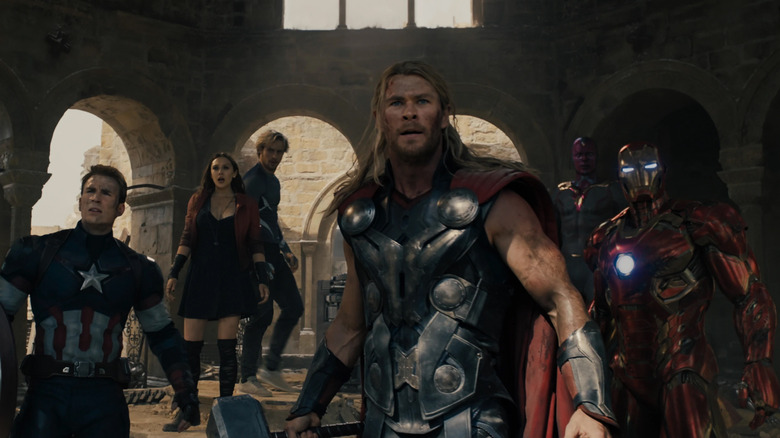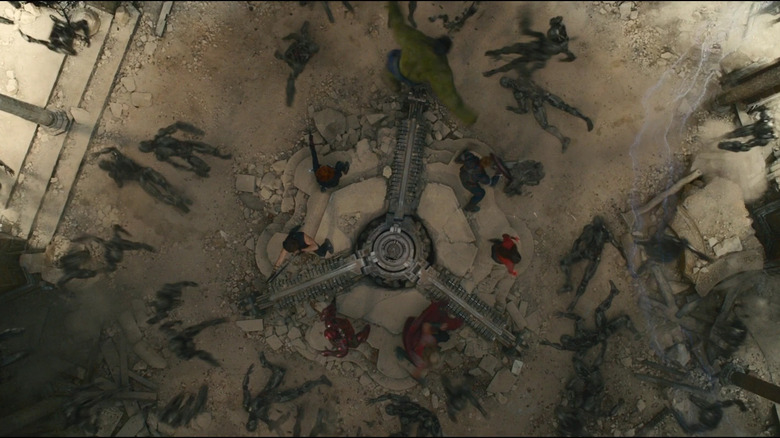The Hardest Stunt To Pull Off In Avengers: Age Of Ultron
In 2016, I attended a conversation between filmmaker Joss Whedon and actor Mark Ruffalo, who Whedon recruited to star in "The Avengers" as Bruce Banner/The Hulk. Hosted by the Tribeca Film Festival, this was the same one where Whedon said "Avengers: Age of Ultron" made him feel like "a miserable failure."
During the talk, Whedon confessed how he feels that he lacks the eye of a great director. This moment of vulnerability by Whedon stuck out to me because it echoed criticism of his work I'd absorbed online as a budding cinephile (before we learned there was a lot more to criticize about Whedon's behavior, on the MCU and elsewhere). These critics would argue that Whedon's directing never matured past middling TV-level craft, as seen on "Buffy The Vampire Slayer." At the time, I was one of the Whedon faithful and stubbornly refused to see it, but my mind has been cleared now.
Gita Jackson, writing for Vice in 2022, argues that while Whedon is a screenwriter, he never learned how to think about his storytelling beyond words: "[Whedon] rarely uses montage or juxtaposition or even visual metaphor to portray how characters are feeling—his camera is a distant, objective observer."
If there's any visual flourish I can pin down in Whedon's "Avengers" films, it's how he shoots hero poses like comic book splash pages (full-page action spreads, with detailed backgrounds and many different subjects). Take the 360-degree pan in the third act of "The Avengers," when the team finally comes together and stands back-to-back in a circle; each one gets their hero shot in immediate succession because the Avengers stand united.
In "Age of Ultron," Whedon does the same trick when the Avengers fight off the robotic hordes of Ultron. This one didn't quite recapture the magic, and according to stunt coordinator Greg Powell, it was quite a challenge to stage.
Shooting an action scene like an Avengers comic
Here's the set-up: Ultron has built an anti-gravity device under a city in the European nation Sokovia. He lifts the city into the sky, intending to smack it into the Earth like a meteor. The device's control pillar is located in a church at the city's center; if Ultron touches the controls, the city drops. The nine Avengers (the six originals plus Vision, Scarlet Witch, and Quicksilver) thus have to guard the pillar, standing around it in a circle.
Speaking to MovieWeb in 2015, Powell said the complexity of the scene (choreographing the action for all nine stars) made the sequence a challenge. "To do that with all of the major actors in one scene, was difficult, but you had to be on your toes that day," he recalled.
Was that effort worth it? The sequence begins with a montage (really a cacophony) of extreme close-ups (rewatch above), showing one of the Avengers each destroying Ultron drones. It's cut together carelessly, with little rhythm beyond the sound of smashing metal. Then, the scene transitions to the 360-degree pan as the music score swells, communicating that the Avengers are now working together as a team. And then it goes back to the same bumpy cutting.
When a comic artist illustrates a splash page, they have complete control; the entire image begins with their pencil and they can place each figure wherever they want. Just look at the concept art of the "Age of Ultron" final battle by artist Charlie Wen, which is much cleaner than the battle as filmed. Unlike a pen-and-paper artist, a filmmaker has to block tangible objects (and people) before a camera's field of view. Both jobs take a lot of skill, but this is why, when it comes to showing complex superhero battles, comics remain the superior medium.

